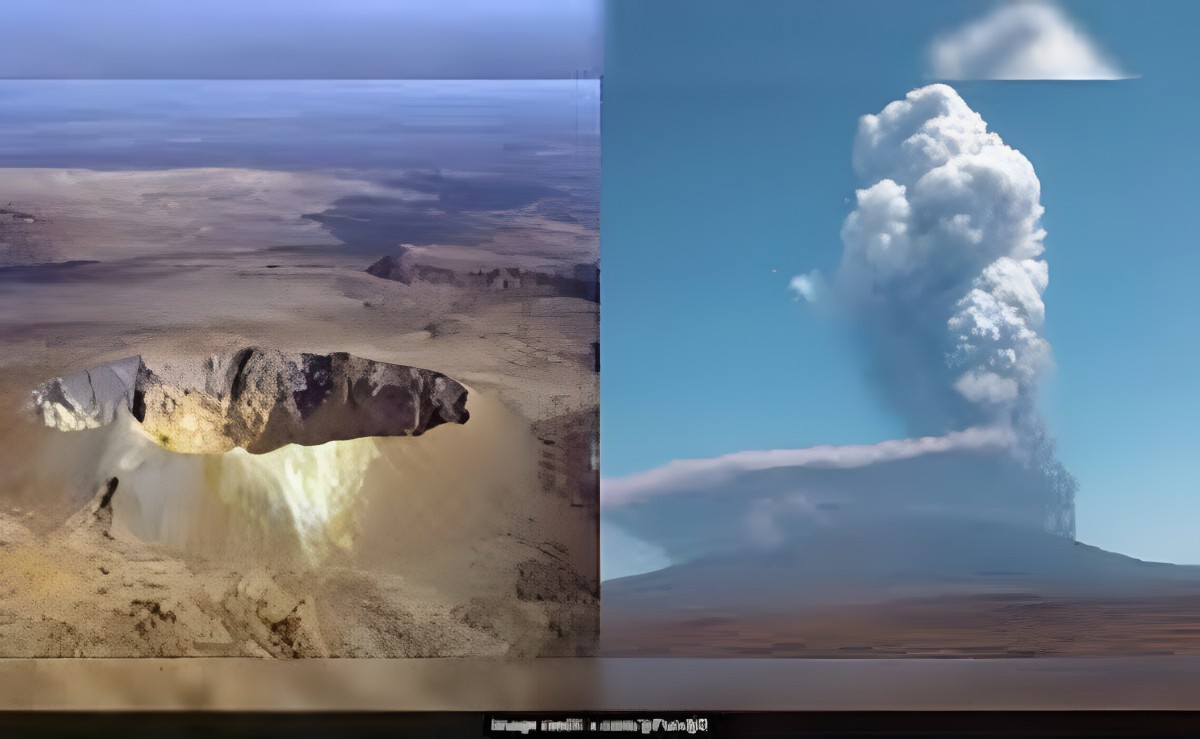A powerful volcanic eruption in Ethiopia has triggered global alerts as aviation authorities, meteorologists and disaster-response agencies closely monitor its fast-moving ash cloud. The Hayli Gubbi volcano, located in the Afar Rift region, erupted suddenly after remaining dormant for several thousand years, sending a towering column of ash and gases high into the atmosphere. Within hours, its plume began affecting air routes across Africa, the Middle East, and South Asia.
Also Read: Brazilian Model Larissa Responds to Allegations of Rahul Gandhi’s Vote Chori Connection
🔥 A Rare Geological Event Shocks Scientists
The eruption began with almost no warning. Satellite sensors detected a strong thermal signature as molten material burst from the volcano’s vent, generating a massive ash plume that climbed nearly 15 kilometers into the stratosphere. Scientists immediately classified the eruption as high-intensity, given the height, density, and reach of the ash cloud.
Geologists are calling this a historic event, because Hayli Gubbi had shown no recorded eruption in human history. Its sudden reactivation surprised volcanologists, many of whom now believe the Afar region may host more dormant volcanoes capable of unexpected activity.
Ash Cloud Travels Across Continents
Strong upper-level winds carried the ash plume northeastward over the Red Sea and the Arabian Peninsula. The ash continued its journey across the Arabian Sea, reaching parts of India within 48–72 hours of the eruption.
Although the plume thinned significantly by the time it crossed into South Asia, it remained concentrated enough at high altitudes to interfere with commercial air routes.
Meteorologists have been tracking the cloud using real-time satellite data, confirming its movement toward international flight corridors. Even diluted volcanic ash can severely damage aircraft engines, requiring airlines to divert or delay operations.
Mass Flight Disruptions Across Regions
Aviation authorities responded swiftly. India’s Directorate General of Civil Aviation (DGCA) issued an emergency advisory, urging carriers to avoid ash-affected flight levels, adjust routes, and conduct safety inspections.
Major airlines—such as Air India, IndiGo, and Akasa Air—cancelled several international flights to the Middle East and Africa. Many flights en route were diverted mid-air to avoid hazardous zones.
Airports intensified ground checks to ensure that runways, taxiways, and aircraft surfaces remained ash-free. Even a microscopic layer of ash can damage engines, sensors, and electrical systems.
Passengers across multiple countries experienced delays, re-bookings, and extended airport stays as flight schedules were reorganized.
Ethiopia Global Monitoring Systems Activated
The eruption prompted rapid coordination between international agencies including:
- Volcanic Ash Advisory Centers (VAACs)
- Meteorological departments across Africa, the Middle East, and Asia
- Aviation safety regulators
- Satellite-based Earth-observation networks
Scientists are analyzing sulphur-dioxide emissions and ash composition to understand potential environmental impacts. Although surface-level air quality remained safe in most regions, experts continue to monitor possible effects on climate and atmospheric chemistry.
The event has also reignited discussions about the need to better map dormant volcanoes—especially those in tectonically active regions like the East African Rift.
🔎 Why This Eruption Matters Globally
This eruption demonstrates how a remote geological event can affect the modern world within hours.
Key takeaways:
- Dormant volcanoes can reactivate without warning.
- Ash clouds spread rapidly across continents, disrupting flight paths and global connectivity.
- International monitoring networks are crucial for predicting and responding to airborne hazards.
- Climate and air-quality impacts require careful ongoing observation.
The event also highlights the vulnerability of global aviation systems in the face of natural hazards, underscoring the need for flexible flight-routing strategies and stronger predictive modelling.
✅ Conclusion
The sudden eruption of Ethiopia’s long-silent Hayli Gubbi volcano has captured the world’s attention. Its massive ash plume travelled thousands of kilometers, disrupting air travel and prompting international agencies to launch large-scale monitoring efforts. Although the immediate threat is decreasing as the plume disperses, the event stands as a powerful reminder of Earth’s unpredictable forces.
As scientists study the eruption’s causes and consequences, nations continue to strengthen their early-warning systems and aviation safety protocols. This rare volcanic awakening not only affected regions far beyond Ethiopia but also illustrated how interconnected the modern world has become. The eruption serves as both a scientific opportunity and a global wake-up call: even a single volcano Ethiopia can send ripples across continents in a matter of hours.
Also Read: Climate Change in 2025: Are We Too Late to Reverse It?











